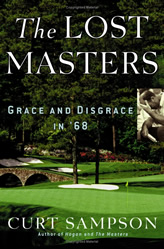The Lost Masters: Grace and Disgrace in ’68
I have a vivid memory of one afternoon in the spring of 1968.
At that time, I could often be found riding my bike in and around Skyline Junior High School, where I was in ninth grade. The school had that name because it sat near the top of one of the higher hills in northern Delaware, with great views of Wilmington and the Delaware River several miles away.
On this day, a buddy and I were riding up near the school, and we looked toward Wilmington.
From that distance, the huge cloud of smoke made it look like most of Delaware’s only major city was on fire.
It was vivid evidence of how many city folks reacted to the news of the assassination of the Reverend Martin Luther King, Jr.
Golf was not in my life then, so I paid no attention to the 1968 Masters Tournament, held shortly after King’s murder. On the other hand, Curt Sampson was a busy young caddie in Ohio at the time, full of speculation and careful consideration of the chances for victory among the top players, including Jack Nicklaus and Tom Weiskopf.
His own memories of that year’s events, including the screw-ups that led to the crowning of Bob Goalby as the 1968 Masters champion, are well-interspersed throughout this remarkable book.
Those of us old enough to remember 1968 readily recall the incidents that shaped the nation during that turbulent time and for many years thereafter. We sometimes forget, however, that far more folks today only know about that year from what they read about it.
Sampson integrates the sports story about the mortally-ill Bobby Jones, Goalby, and South America’s best golfer, Roberto De Vicenzo, into the broader tale about everyday life in the United States, in a year that came to symbolize the era.
For example, one of the most hotly debated themes in the 1960s dealt with fairness, a fundamental political goal with widely varying shades of meaning among those doing the debating. This issue was also central to the scoring controversy that marred the Tournament’s reputation that year, after decades of careful cultivation.
The participant selection process for the Masters usually rewards repeat attendees, and that year’s event was no different. The early lines on the pros coming to Augusta centered on the usual triumvirate of Nicklaus, Player, and Palmer, and gave short shrift to other golfers who had yet to win a green jacket, such as De Vicenzo and Goalby.
Sampson provides a sensitive character study of both golfers, describing their past and how it helped shape their approach to golf, competition, and their reaction to their shared history in the years after 1968. Sampson also uses the caddie system then in place at The Masters as way to show how different professional golf was then from what it is now. This sub-plot also serves as a useful reminder of the racial dynamics of both the South and the sport forty years ago.
The accepted wisdom of that spring had no apparent effect on De Vicenzo and Goalby, whose play at Augusta showed no signs of excessive attention to press clippings. De Vicenzo, a past British Open winner, played at or near the top of the leader board for the entire event. Goalby stayed close behind, fighting his hook, but outperforming his prior efforts in the Masters.
As Sampson shows, the high level of professional skill displayed by these golfers was not matched by the level of effort devoted to running the event. The flawed arrangements for reporting scores, in combination with the emotionally draining efforts by Goalby and De Vicenzo over the last few holes that Sunday, were a major cause of the famous rules controversy.
Complicating matters further, Bobby Jones was still in charge. The volunteers working the event turned to Jones for guidance, along with co-founder Cliff Roberts.
We are left to wonder about the degree to which the official description of the decision-making process is an accurate representation. Sampson clearly has his doubts about that, while supporting his own interpretation with careful analysis of the evidence that remains.
You might not think that a single golf tournament, however unusual its history, could provide enough material for a full-length book treatment. Nonetheless, Sampson’s ability to incorporate the 1968 Masters into the larger picture of that unusual year makes this book a compelling social history, well worth reading.
Review date: January 28, 2006


